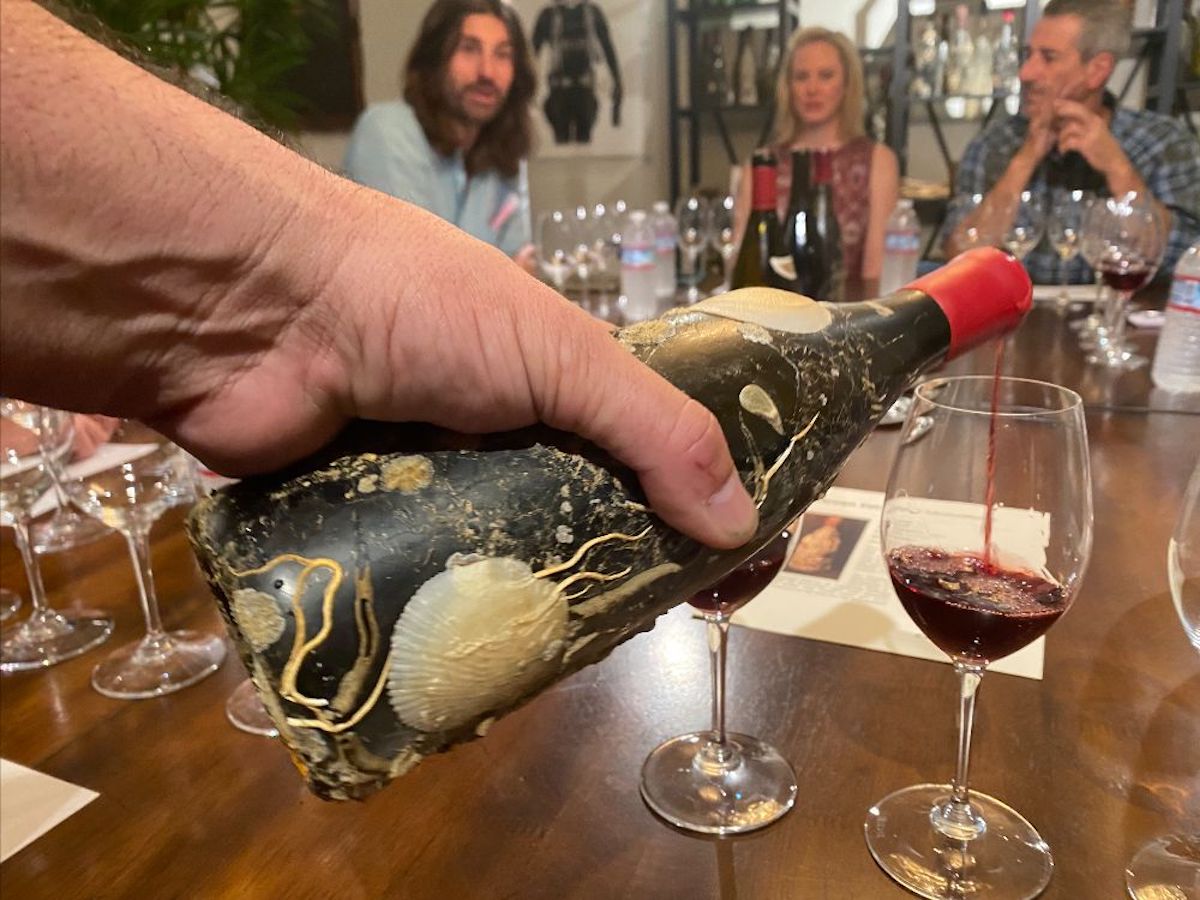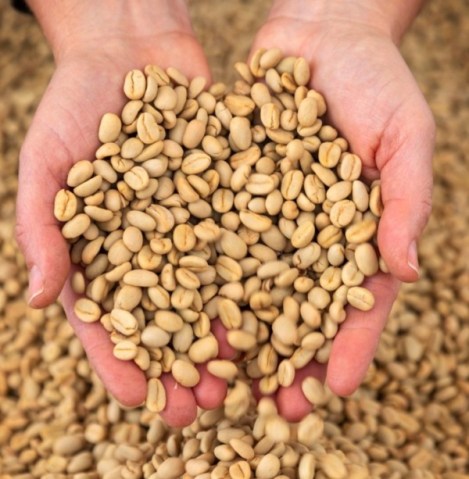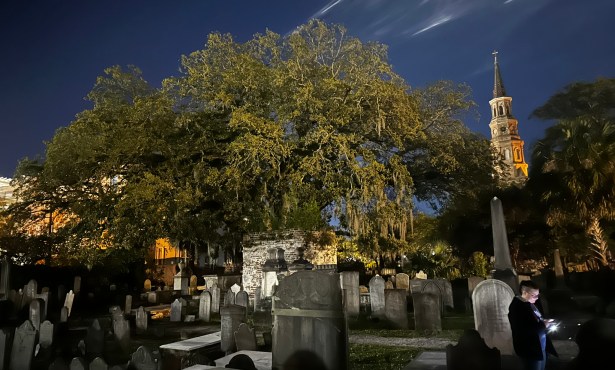Full Belly Files: Diving Into Underwater Wine
From Shipwrecked Wine to Seaside Dives

This holiday season, we’re bringing you the best in our newsletters from 2021. Sign up for content like this and more here.
“I think I like the underwater wine a little better.”
That’s me, being quoted by the renowned columnist Steve Lopez in the Los Angeles Times this past weekend, in his story about a comparative tasting of the wines that Santa Barbara–based company Ocean Fathoms is aging under the sea in cages just off the shores of East Beach. Lopez tuned into this story by chance this summer, getting a tip that this unique idea was running into permitting challenges with the California Coastal Commission. (My colleague Jun Starkey followed that report with her own story for our paper, which put a local political spin on it.)
Though his initial report cast Ocean Fathoms in a somewhat harsh light — “The ocean is not your private wine locker, guys,” the column explained of the Coastal Commission stance, “so get the wine out of the water or face fines that could run in the tens of thousands of dollars” — Lopez remained open-minded about the claims that the underwater wine could be better than the same wine that stayed on shore. The concept is not entirely novel: Wine found in shipwrecks is known to exhibit rather wonderful qualities many centuries later, and numerous wineries across Europe and the Mediterranean are experimenting with the technique today.

But this is the first time that someone is trying to do so in California waters, and with Santa Barbara County wines as well. So Lopez rounded up the palates of vintners Kathy Joseph of Fiddlehead, Laura Booras of Riverbench, and Peter Stolpman of Stolpman to sample these sea-aged sips. The latter also suggested adding me to the crew, given that I regularly taste more Central Coast wine than probably anyone on the planet.
We gathered on a Tuesday afternoon in late October at the company’s headquarters, located in a warehouse on Quinientos Street, not far from the sea itself but closer to the unhoused masses who linger by the gas stations and shelters of Milpas and Cacique streets. Our already hefty tasting crew was joined by an even larger contingent of Ocean Fathoms folks, including founder Emanuele Azzaretto, who was inspired to start this project years ago when he couldn’t get his hands on a stash of shipwrecked wine.

After a tour of the facility, from the stacks of shell-encrusted bottles that have endured the 12-month treatment to the special monitors they’re developed to track the aging process in real time, we sat around a table upstairs, where the tasting commenced.
This was not the first time I heard about his project, nor the first time I tasted the wine. Someone told me about it way back in 2017, and I had a brief correspondence with one of the co-proprietors, Todd Hahn, who’s a sports agent by career. There was brief talk of delivering me some wine to try, but then I heard nothing until February of this year, when Hahn reached out again. On the advice of sommelier Rajat Parr, also now part of the Ocean Fathoms team, Hahn invited me to be part of the “Sea Cellar Adventure,” a March 13 cruise on the Channel Cat from the Santa Barbara Harbor out to where the cage would be pulled up before our eyes.

The adventure was indeed adventurous. The crowd was fairly thick, despite that week’s surging COVID rates; you could stay outside in the breeze pretty easily, as I mostly did, but you had to go inside for drinks and to queue up to try the wines. (No superspreading occurred, as far as I know.) The seas were tumultuous that day, so much so that they had to yank the bottle cage out of the ocean before our boatload of onlookers arrived — a k a, the main event happened unseen.
The smaller boats following us out were pitching to and fro in severe ways, and even the Channel Cat was steadily bobbing on the way back, causing a bit of vomiting and plenty of pale faces. Then there was the unfortunate incident where a sea lion or seal that was supposed to be released by Channel Islands Marine and Wildlife Institution, which was benefiting from the event, wound up falling off the back of the boat, still in its cage. The wildlife experts on board immediately assured that the gate would open in time, but it was a worrisome scene. Even I started to feel a little seasick at that point, and that never happens.
Along the way and then once back in the harbor, we tried both the topside and the underwater wines, which was a Super Tuscan blend made from Santa Barbara grapes by Marco Lucchesi of Section Wines. Given the action-packed adventure, I can’t say that I was paying a ton of attention to the nuances, but I did notice a smoothness to the underwater wine that was different from the more tannic topside version.
And that’s essentially what we found when tasting with Lopez. The first wine was a 2016 Domaine de la Côte “Memorius” pinot noir by Sashi Moorman and Raj Parr, who called into the tasting through a very spotty FaceTime link while dealing with harvest issues that day.
I found the topside bottle — which Hahn could only track down from Germany and for $200-plus — to be rather wild, tart, and herbally funky, while the underwater wine was better integrated and a bit more focused. That’s about what everyone else thought too.

The second wine — again, that Section Super Tuscan from 2016 — was even more distinct. This one we did blind, with the topside version showing sharper, intense tannins, while the underwater version offered more smoothed-out mouthfeel, with the oak more deliciously laced into the dried red fruit flavors.
In short, we all agreed that the underwater versions were indeed different than the topside wines, and we were also unanimous in thinking that they tasted better at that point in time as well. There’s a lot of near-wizardry in explaining why this would make a difference, but the loose idea that at least passes the common-sense test is that the gentle movement of the ocean combined with the cool, dark conditions sets the wine on a different aging path, one that rounds out the hard corners sooner than just sitting in a cool, dark, yet dry and above-sea-level cellar.
Of course, many more questions remain unanswered: Would longer underwater aging create more pronounced differences? Does this work best on expensive wine, or would it work on cheap wine too? Would an everyday consumer notice any difference at all, or is this an exercise for trained palates? Who will be willing to pay the high prices for underwater bottles, which can be $350 a pop?
But there’s even a critical question that needs answering before we can really contemplate any of those: Will the Coastal Commission ever let Ocean Fathoms continue their project? If not, expect those existing bottles to skyrocket even more in price. If you’re got that sort of budget and a passion for wine, they’re certainly worth a try.
This edition of Full Belly Files was originally emailed to subscribers on November 3, 2021. To receive Matt Kettmann’s food newsletter in your inbox, sign up at independent.com/newsletters.
Santa Barbara County: Wine Region of the Year

I’ve been quoted in other publications a few times over the years. The first time was almost two decades ago, when the News-Press ran an article about some scoop I had in covering Sheriff Jim Thomas’s bid for the County Supervisor seat — as a cub reporter, I thought that was kinda cool, and I still have a copy of it somewhere. Since then, most of my appearances have been related to wine, like this time when I stood up a bit for Temecula Valley.
This week, it happened a few times. There was the L.A. Times column from above and then Laurie Jervis’s report in Noozhawk about how Santa Barbara County was named Wine Region of the Year by Wine Enthusiast. That news also caught attention from numerous other publications, including here at the Santa Barbara Independent.
And that’s where things get a little meta. As a contributing editor for Wine Enthusiast, I’ve been lobbying for Santa Barbara to be recognized with this award for years, although the ultimate decision was up to the magazine’s executive team in New York. When they did opt for Santa Barbara, I was asked to write the piece, which I did. When it came time for the Independent to relay this exciting news, the easiest and fastest way was for me to write the story, which I did anonymously under our Indy Staff banner, and then quote the original award article, which I also did without naming the author, since that was myself. And here’s that story.
Now the job is up to the Santa Barbara Vintners and the entire wine country community to continue banging that drum. It is a global recognition and can be flexed for years to come. Paso Robles won the same award when I was first hired by the magazine back in 2014, and they pumped it for all it was worth. Lodi did the same a few years later. I hope we do the same.
No matter what, there’s a party! In February, Wine Enthusiast will host the Wine Star Awards in Miami, where I look forward to celebrating alongside my winemaker friends who make the trek.
From Our Table

I was too busy to write Full Belly Files last week, so I’ve got a lot to catch you up on.
- I really hope you saw my cover story last week on Frinj Coffee. I went pretty deep into the reporting to explain how a Goleta farmer named Jay Ruskey is trying to develop a brand-new California industry and improve equity in the global coffee market along the way. Read that here.
- In this week’s paper, I cover Simple Feast, a Danish company that’s now headquartered its American operations in a Santa Barbara test kitchen (actually, the former Wildwood Kitchen). Really tasty food, all plant-based, and a great mission. Get a veggie forkful here.
- I also write about actor-turned-vintner Sunny Doench, the smiling face behind Future Perfect Wines. Sip up here.
- Last week, Rebecca Horrigan got an early look at Centennial Beer Hall, the new bar that occupies the legendary space that was once the Mercury Lounge in Old Town Goleta. Chug her report here.
- Then Camille Garcia dove into the Oaxacan online market La Calenda, owned by Bany Vargas. Check out the cultural offerings here.
- And going back a number of weeks now, my longtime colleague George Yatchisin sidled up to the Riviera Bar to report on what’s going on in the former Sportsman Lounge space. Check that out here.




You must be logged in to post a comment.